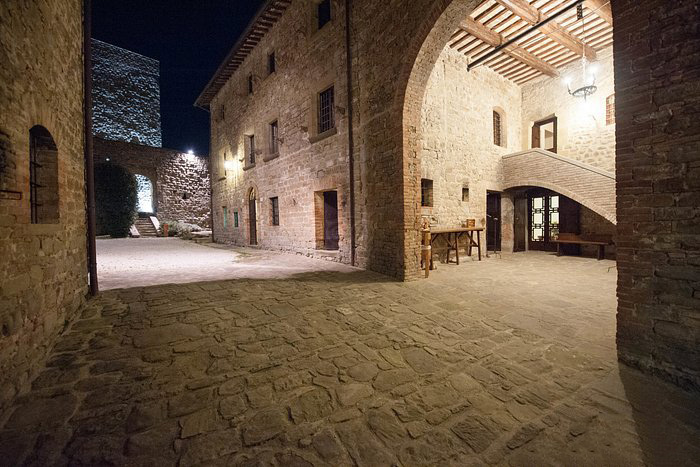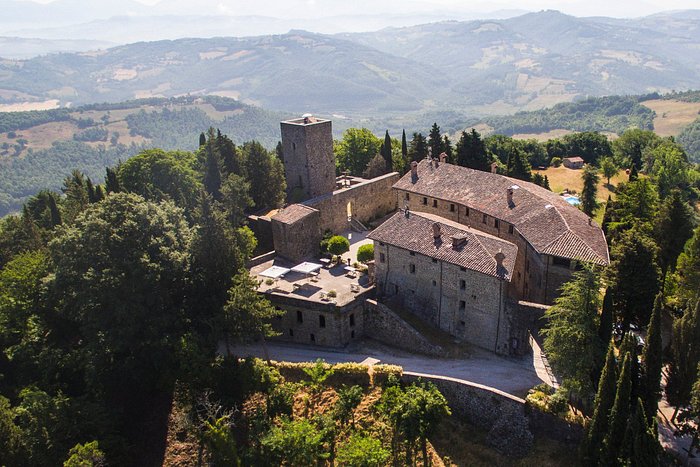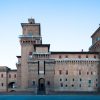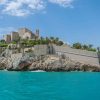Castello di Petroia
The Castello di Petroia is an impressive medieval castle located in Umbria, Italy. This region is renowned for its breathtaking landscapes and historic architecture. The castle sits on a secluded hilltop and overlooks a vast expanse of Italian countryside. It preserves the essence of a bygone era. Today, it serves both as a heritage site and an exclusive hotel. This allows guests to experience history within its ancient stone walls. Castello di Petroia offers a truly unique window into the past. Visitors are invited to explore centuries-old architecture and artifacts while enjoying the beauty of its natural surroundings.
Location of Castello di Petroia
Castello di Petroia is located near Gubbio, approximately 20 kilometers from Perugia, the capital of Umbria. Notably, perched atop a hill, it offers expansive views of the lush valleys and rolling hills characteristic of this region. Its setting is one of tranquility, surrounded by over 800 hectares of protected land. Additionally, the landscape around the castle includes olive groves, forests, and meadows. This natural beauty provides visitors with ample opportunity to explore the pristine Umbrian countryside.
Historically, this location allowed the castle to monitor important trade and travel routes through Umbria. In medieval times, its elevated position was strategic, offering both visibility and defense. Today, the area around the castle is accessible by road, connecting it easily to nearby cultural centers like Gubbio and Assisi. Visitors find themselves well-positioned to experience both the peace of nature and the rich history that Umbria’s towns and landmarks offer.

History of Castello di Petroia
Castello di Petroia traces its roots back to the early Middle Ages. Records indicate its existence as early as the 9th century. It was originally built as a fortified residence for the Counts of Petroia. The castle quickly became a center of power in the region. Over the subsequent centuries, it played a significant role in the political and military conflicts that defined the medieval Italian landscape. Moreover, its strategic location made it a sought-after prize for various noble families. These included the influential Montefeltro and Della Rovere families.
In 1422, an important event brought further prominence to Castello di Petroia. It became the birthplace of Federico da Montefeltro, a central figure of the Italian Renaissance. Federico would eventually rise to fame as the Duke of Urbino and gain renown as a patron of the arts and an astute political leader. His birth placed Castello di Petroia in the annals of Italian history, marking it as a site with both cultural and historical significance.
Throughout its history, Castello di Petroia has seen numerous modifications and additions. Defensive features, such as guard towers and battlements, were reinforced to protect it during conflicts. Over time, the castle transitioned from a defensive structure to a noble residence. By the late 19th century, however, it had begun to fall into disrepair. Efforts to restore the castle in the 20th century aimed to preserve its unique medieval character while making it accessible for future generations.

Current status
Today, Castello di Petroia stands as both a historical site and a boutique hotel. It offers guests an authentic glimpse into medieval life with the comforts of modern amenities. The castle’s rooms and suites have been carefully restored to maintain their original architecture. These rooms feature high ceilings, stone walls, and antique furnishings. Each space has been designed to reflect the medieval atmosphere. This careful design provides an immersive experience for those who stay within its walls.
The castle’s grounds have been designated as a nature preserve, protecting the surrounding landscape from development and ensuring that visitors experience an untouched version of Umbria’s countryside. Walking trails lead through groves of olive trees and forested areas, allowing guests to connect with nature. Activities such as horseback riding and bird watching are available, adding to the castle’s appeal for eco-tourists and nature lovers.
In addition to accommodation, Castello di Petroia frequently hosts events, including weddings, historical reenactments, and cultural gatherings. These events are often held in the grand hall, a beautifully preserved space adorned with medieval tapestries and period furnishings. By hosting such events, the castle fosters a connection between history and the present day, celebrating Italy’s heritage in a unique and memorable setting.
Admission
Community features
Castle features
Video
Location
Official website
Featured listings














